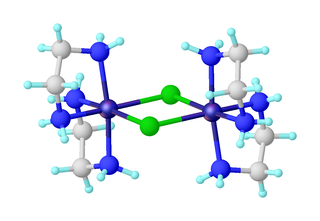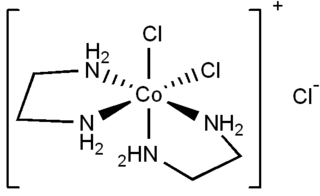Related Research Articles
Chelation is a type of bonding of ions and molecules to metal ions. It involves the formation or presence of two or more separate coordinate bonds between a polydentate ligand and a single central metal atom. These ligands are called chelants, chelators, chelating agents, or sequestering agents. They are usually organic compounds, but this is not a necessity.

Ethylenediaminetetraacetic acid (EDTA), also called EDTA acid after its own abbreviation, is an aminopolycarboxylic acid with the formula [CH2N(CH2CO2H)2]2. This white, water-insoluble solid is widely used to bind to iron (Fe2+/Fe3+) and calcium ions (Ca2+), forming water-soluble complexes even at neutral pH. It is thus used to dissolve Fe- and Ca-containing scale as well as to deliver iron ions under conditions where its oxides are insoluble. EDTA is available as several salts, notably disodium EDTA, sodium calcium edetate, and tetrasodium EDTA, but these all function similarly.
EDP may refer to:

Catechol, also known as pyrocatechol or 1,2-dihydroxybenzene, is an organic compound with the molecular formula C6H4(OH)2. It is the ortho isomer of the three isomeric benzenediols. This colorless compound occurs naturally in trace amounts. It was first discovered by destructive distillation of the plant extract catechin. About 20,000 tonnes of catechol are now synthetically produced annually as a commodity organic chemical, mainly as a precursor to pesticides, flavors, and fragrances.
The Griess test is an analytical chemistry test which detects the presence of nitrite ion in solution. One of its most important uses is the determination of nitrite in drinking water. The Griess diazotization reaction, on which the Griess reagent relies, was first described in 1858 by Peter Griess. The test has also been widely used for the detection of nitrates, which are a common component of explosives, as they can be reduced to nitrites and detected with the Griess test.

Aminophylline is a compound of the bronchodilator theophylline with ethylenediamine in 2:1 ratio. The ethylenediamine improves solubility, and the aminophylline is usually found as a dihydrate.

Ethylenediamine (abbreviated as en when a ligand) is the organic compound with the formula C2H4(NH2)2. This colorless liquid with an ammonia-like odor is a basic amine. It is a widely used building block in chemical synthesis, with approximately 500,000 tonnes produced in 1998. Ethylenediamine is the first member of the so-called polyethylene amines.

Diethylenetriamine (abbreviated Dien or DETA) and also known as 2,2’-Iminodi(ethylamine)) is an organic compound with the formula HN(CH2CH2NH2)2. This colourless hygroscopic liquid is soluble in water and polar organic solvents, but not simple hydrocarbons. Diethylenetriamine is structural analogue of diethylene glycol. Its chemical properties resemble those for ethylene diamine, and it has similar uses. It is a weak base and its aqueous solution is alkaline. DETA is a byproduct of the production of ethylenediamine from ethylene dichloride.

Chloropyramine is a classical first-generation antihistamine drug approved in Eastern European countries for the treatment of allergic conjunctivitis, allergic rhinitis, bronchial asthma, and other atopic (allergic) conditions. Related indications for clinical use include angioedema, allergic reactions to insect bites, food and drug allergies, and anaphylactic shock.

1,2-Dimethoxybenzene, commonly known as veratrole, is an organic compound with the formula C6H4(OCH3)2. It is one of three isomers of dimethoxybenzene. It is a colorless liquid, with a pleasant odor and slight solubility in water. It is the dimethyl ether derived from pyrocatechol.
A diamine is an amine with exactly two amino groups. Diamines are used as monomers to prepare polyamides, polyimides, and polyureas. The term diamine refers mostly to primary diamines, as those are the most reactive.

Aminoethylethanolamine or AEEA is an organic base used in the industrial manufacture of fuel and oil additives, chelating agents, and surfactants.
Ethylenediamine dihydroiodide (EDDI) is a water-soluble salt derived from ethylenediamine and hydroiodic acid. It is a colorless to light yellow crystalline powder. The salt consists of the ethylenediammonium dication C2H4(NH3)22+ and iodide anions.

Tris(ethylenediamine)cobalt(III) chloride is an inorganic compound with the formula [Co(en)3]Cl3 (where "en" is the abbreviation for ethylenediamine). It is the chloride salt of the coordination complex [Co(en)3]3+. This trication was important in the history of coordination chemistry because of its stability and its stereochemistry. Many different salts have been described. The complex was first described by Alfred Werner who isolated this salt as yellow-gold needle-like crystals.

Lucifer yellow is a fluorescent dye used in cell biology. The key property of Lucifer yellow is that it can be readily visualized in both living and fixed cells using a fluorescence microscope. Lucifer yellow was invented by Walter W. Stewart at the National Institutes of Health and patented in 1978.

Dichlorobis(ethylenediamine)nickel(II) is the inorganic compound with the formula NiCl2(en)2, where en = ethylenediamine. The formula is deceptive: the compound is the chloride salt of the coordination complex [Ni2Cl2(en)4]2+. This blue solid is soluble in water and some polar organic solvents. It is prepared by ligand redistribution from [Ni(en)3]Cl2 · 2 H2O and hydrated nickel chloride:

cis-Dichlorobis(ethylenediamine)cobalt(III) chloride is a salt with the formula [CoCl2(en)2]Cl (en = ethylenediamine). The salt consists of a cationic coordination complex and a chloride anion. It is a violet diamagnetic solid that is soluble in water. One chloride ion in this salt readily undergoes ion exchange, but the two other chlorides are less reactive, being bound to the metal center.

Palladium(II) bromide is an inorganic compound of palladium and bromine with the chemical formula PdBr2. It is a commercially available, although less common than palladium(II) chloride, the usual entry point to palladium complexes. It is a diamagnetic solid.

N-(1-Naphthyl)ethylenediamine is an organic compound. It is commercially available as part of Griess reagents, which find application in quantitative inorganic analysis of nitrates, nitrite and sulfonamide in blood, using the Griess test.

trans-Dichlorobis(ethylenediamine)cobalt(III) chloride is a salt with the formula [CoCl2(en)2]Cl (en = ethylenediamine). It is a green diamagnetic solid that is soluble in water. It is the monochloride salt of the cationic coordination complex [CoCl2(en)2]+. One chloride ion in this salt readily undergoes ion exchange but the two other chlorides are less reactive, being bound to the metal center. The more stable cis-dichlorobis(ethylenediamine)cobalt(III) chloride is also known.
References
- 1 2 3 Microfabrication:Wet-Etching, University of Washington, College of Engineering